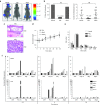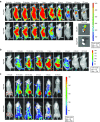Targeted inhibition of prostate cancer metastases with an RNA aptamer to prostate-specific membrane antigen
- PMID: 24954476
- PMCID: PMC4429728
- DOI: 10.1038/mt.2014.117
Targeted inhibition of prostate cancer metastases with an RNA aptamer to prostate-specific membrane antigen
Abstract
Cell-targeted therapies (smart drugs), which selectively control cancer cell progression with limited toxicity to normal cells, have been developed to effectively treat some cancers. However, many cancers such as metastatic prostate cancer (PC) have yet to be treated with current smart drug technology. Here, we describe the thorough preclinical characterization of an RNA aptamer (A9g) that functions as a smart drug for PC by inhibiting the enzymatic activity of prostate-specific membrane antigen (PSMA). Treatment of PC cells with A9g results in reduced cell migration/invasion in culture and metastatic disease in vivo. Importantly, A9g is safe in vivo and is not immunogenic in human cells. Pharmacokinetic and biodistribution studies in mice confirm target specificity and absence of non-specific on/off-target effects. In conclusion, these studies provide new and important insights into the role of PSMA in driving carcinogenesis and demonstrate critical endpoints for the translation of a novel RNA smart drug for advanced stage PC.
Figures





Comment in
-
A theranostic "SMART" aptamer for targeted therapy of prostate cancer.Mol Ther. 2014 Nov;22(11):1886-8. doi: 10.1038/mt.2014.190. Mol Ther. 2014. PMID: 25365986 Free PMC article. No abstract available.
Similar articles
-
A theranostic "SMART" aptamer for targeted therapy of prostate cancer.Mol Ther. 2014 Nov;22(11):1886-8. doi: 10.1038/mt.2014.190. Mol Ther. 2014. PMID: 25365986 Free PMC article. No abstract available.
-
Second-generation aptamer-conjugated PSMA-targeted delivery system for prostate cancer therapy.Int J Nanomedicine. 2011;6:1747-56. doi: 10.2147/IJN.S23747. Epub 2011 Aug 19. Int J Nanomedicine. 2011. PMID: 21980237 Free PMC article.
-
Structural basis of prostate-specific membrane antigen recognition by the A9g RNA aptamer.Nucleic Acids Res. 2020 Nov 4;48(19):11130-11145. doi: 10.1093/nar/gkaa494. Nucleic Acids Res. 2020. PMID: 32525981 Free PMC article.
-
Efficacy Against Human Prostate Cancer by Prostate-specific Membrane Antigen-specific, Transforming Growth Factor-β Insensitive Genetically Targeted CD8+ T-cells Derived from Patients with Metastatic Castrate-resistant Disease.Eur Urol. 2018 May;73(5):648-652. doi: 10.1016/j.eururo.2017.12.008. Epub 2017 Dec 21. Eur Urol. 2018. PMID: 29275833 Free PMC article. Review.
-
Radiolabeled enzyme inhibitors and binding agents targeting PSMA: Effective theranostic tools for imaging and therapy of prostate cancer.Nucl Med Biol. 2016 Nov;43(11):692-720. doi: 10.1016/j.nucmedbio.2016.08.006. Epub 2016 Aug 11. Nucl Med Biol. 2016. PMID: 27589333 Review.
Cited by
-
Ets1 identified as a novel molecular target of RNA aptamer selected against metastatic cells for targeted delivery of nano-formulation.Oncogene. 2015 Oct 8;34(41):5216-28. doi: 10.1038/onc.2014.447. Epub 2015 Feb 2. Oncogene. 2015. PMID: 25639877 Free PMC article.
-
An Apta-Biosensor for Colon Cancer Diagnostics.Sensors (Basel). 2015 Sep 3;15(9):22291-303. doi: 10.3390/s150922291. Sensors (Basel). 2015. PMID: 26404293 Free PMC article.
-
In vivo imaging of prostate cancer using an anti-PSMA scFv fragment as a probe.Sci Rep. 2016 Mar 21;6:23314. doi: 10.1038/srep23314. Sci Rep. 2016. PMID: 26996325 Free PMC article.
-
Evolution of Complex Target SELEX to Identify Aptamers against Mammalian Cell-Surface Antigens.Molecules. 2017 Jan 30;22(2):215. doi: 10.3390/molecules22020215. Molecules. 2017. PMID: 28146093 Free PMC article. Review.
-
A comparative analysis of cell surface targeting aptamers.Nat Commun. 2021 Nov 1;12(1):6275. doi: 10.1038/s41467-021-26463-w. Nat Commun. 2021. PMID: 34725326 Free PMC article.
References
-
- Cereda V, Formica V, Massimiani G, Tosetto L, Roselli M. Targeting metastatic castration-resistant prostate cancer: mechanisms of progression and novel early therapeutic approaches. Expert Opin Investig Drugs. 2014;23:469–487. - PubMed
-
- Shah N, Dizon DS. New-generation platinum agents for solid tumors. Future Oncol. 2009;5:33–42. - PubMed
-
- Ghosh A, Heston WD. Tumor target prostate specific membrane antigen (PSMA) and its regulation in prostate cancer. J Cell Biochem. 2004;91:528–539. - PubMed
-
- Israeli RS, Powell CT, Corr JG, Fair WR, Heston WD. Expression of the prostate-specific membrane antigen. Cancer Res. 1994;54:1807–1811. - PubMed
Publication types
MeSH terms
Substances
Grants and funding
LinkOut - more resources
Full Text Sources
Other Literature Sources
Medical
Miscellaneous

